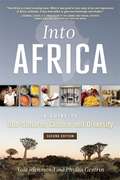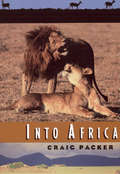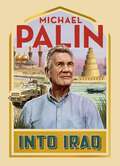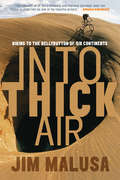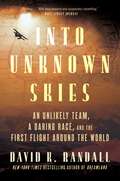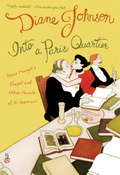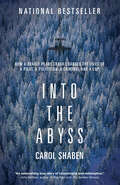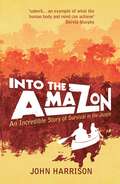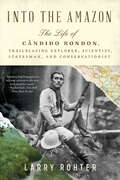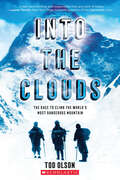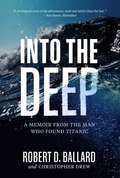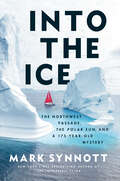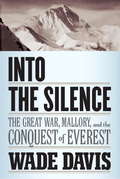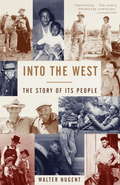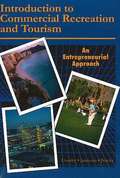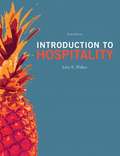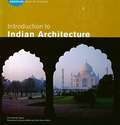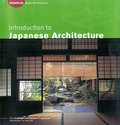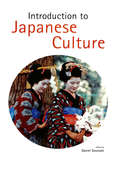- Table View
- List View
Into Africa: A Guide To Sub-saharan Culture And Diversity (Interact Ser.)
by Yale Richmond Phyllis GestrinAcross the globe, Africa is seen as the final frontier for economic development and has experienced renewed attention from both Western and Eastern nations, particularly in the last decade. The U. S. , India, China and parts of Europe have all increased foreign direct investment in Africa, and yet the complexity and diversity of this vast continent pose risks and challenges for those investments. For more than a decade, Into Africa has provided valuable advice to those who are interested in traveling to, living in or working in sub-Saharan Africa'businesspeople, human rights and development workers, diplomats, academics and trainers'and anyone else who seeks a better understanding of the cultural characteristics of this dynamic part of the world. With depth and sensitivity, Into Africa examines the effects of community, ethnicity and language on doing business and establishing professional and personal relationships in African countries. The book explores regional differences, offers detailed guidelines for conducting training programs in Africa and examines issues that reflect the complex relationships involved. This new and expanded edition of Into Africa brings a fresh view on sub-Saharan Africa, showing how the nations of Africa have adapted to Western ways while retaining their cultural traditions and diversity. Authors Yale Richmond and Phyllis Gestrin explore contemporary Africa in great depth, discussing increased trade with the U. S. and Europe, the role of politics and business, changes in mass communication and the continuing threat of HIV/AIDS. A thorough, lively and carefully researched book, Into Africa is the perfect companion for anyone wishing to gain a more rounded perception of Africa and its diverse cultures.
Into Africa: With a New Postscript
by Craig PackerCraig Packer takes us into Africa for a journey of fifty-two days in the fall of 1991. But this is more than a tour of magnificent animals in an exotic, faraway place. A field biologist since 1972, Packer began his work studying primates at Gombe and then the lions of the Serengeti and the Ngorongoro Crater with his wife and colleague Anne Pusey. Here, he introduces us to the real world of fieldwork—initiating assistants to lion research in the Serengeti, helping a doctoral student collect data, collaborating with Jane Goodall on primate research. As in the works of George Schaller and Cynthia Moss, Packer transports us to life in the field. He is addicted to this land—to the beauty of a male lion striding across the Serengeti plains, to the calls of a baboon troop through the rain forests of Gombe—and to understanding the animals that inhabit it. Through his vivid narration, we feel the dust and the bumps of the Arusha Road, smell the rosemary in the air at lunchtime on a Serengeti verandah, and hear the lyrics of the Grateful Dead playing off bootlegged tapes. Into Africa also explores the social lives of the animals and the threats to their survival. Packer grapples with questions he has passionately tried to answer for more than two decades. Why do female lions raise their young in crèches? Why do male baboons move from troop to troop while male chimps band together? How can humans and animals continue to coexist in a world of diminishing resources? Immediate demands—logistical nightmares, political upheavals, physical exhaustion—yield to the larger inescapable issues of the interdependence of the land, the animals, and the people who inhabit it.
Into Iraq
by Michael PalinIn March 2022, Michael Palin travelled the length of the River Tigris through Iraq to get a sense of what life is like in a region of the world that once formed the cradle of civilisation, but that in recent times has witnessed turmoil and appalling bloodshed. In the journal he kept during his trip he describes the war-ravaged city of Mosul and the children he encounters growing up amid its ruins. He contemplates the graffiti-strewn ruins of Saddam Hussein's former palaces, and he notes the constant presence of armed guards. But there are patches of light amid the dark: boisterous New Year celebrations in Akre, the friendliness of generals and colonels at 'Checkpoint Cheerful', and public poetry readings in Baghdad. People getting on with their lives.At the same time, Michael charts the course of one of the great rivers of the world, showing how the water that gave life to such ancient settlements as Babylon and Ur is now becoming a scarce and hotly contested resource. And he considers the role that Iraq's other great natural resource - oil - plays in both providing wealth and threatening political stability.Illustrated throughout with colour photographs taken on the trip, and permeated with his warmth and humour, this is a vivid and varied portrait of a complex country.
Into Thick Air: Biking to the Bellybutton of Six Continents
by Jim MalusaWith plenty of sunscreen and a cold beer swaddled in his sleeping bag, writer and botanist Jim Malusa bicycled alone to the lowest point on each of six continents, a six-year series of "anti-expeditions" to the "anti-summits." His journeys took him to Lake Eyre in the arid heart of Australia, along Moses' route to the Dead Sea, and from Moscow to the Caspian Sea. He pedaled across the Andes to Patagonia, around tiny Djibouti in the Horn of Africa, and from Tucson to Death Valley. With a scientist's eye, he vividly observes local landscapes and creatures. As a lone man, he is overfed by grandmothers, courted by ladies of the night in Volgograd, invited into a mosque by Africa's most feared tribe, chased by sandstorms and hurricanes - yet Malusa keeps riding. His reward: the deep silence of the world's great depressions. A large-hearted narrative of what happens when a friendly, perceptive American puts himself at the mercy of strange landscapes and their denizens, Into Thick Air presents one of the most talented new voices in contemporary travel writing.
Into Unknown Skies: An Unlikely Team, a Daring Race, and the First Flight Around the World
by David K. Randall“Thrilling . . . With deep research and suspenseful storytelling, Mr. Randall reminds us that America’s pre-eminence in the aviation industry was never assured and that it took a race of unlikely heroes to bring the dream of world flight to the public imagination.”—Wall Street Journal“David K. Randall has conjured the first air race to circumnavigate the globe in all its death-defying glory, featuring a cast of unlikely heroes who had the right stuff before anyone knew what that was.” — Mitchell Zuckoff, New York Times bestselling author of Lost in Shangri-La and 13 Hours“Thrilling reading...an account filled with unexpected layers of intrigue. Recommend Into Unknown Skies to Erik Larson fans.” —BooklistThe unbelievable history of the 1924 race to circumnavigate the globe for the first time by air, a nail-biting contest that pitted underdog US pilots against their better-funded European rivals, created technology that changed aviation, and convinced America that its future was in the sky. In the early 1920s, America’s faith in aviation was in shambles. Twenty years after the Wright Brothers’ first flight, most Americans believed airplanes were for delivering the mail or performing daredevil stunts in front of crowds. The dream of commercial air travel remained just that. Even the American military was a skeptic—rather than pay to bring its planes back from Europe following World War I, the War Department chose to burn most of them instead. All that changed with a single race in 1924. It was not just any race, though—it was a race to become the first to circle the globe in an airplane, pitting a team of underdog American pilots against the best aviators in the world from England, Italy, Portugal, France, and Argentina. Rooted in the same daring spirit that pushed early twentieth-century explorers to attempt crossings of the Antarctic ice or locate the source of the Nile, this race was an adventure unlike anything the world had seen before. The obstacles were daunting—from experimental planes, to dangerous landings in uncharted territory, to the simple navigational gauges that could lead pilots hundreds of miles off course. Failure seemed all but guaranteed—the suspense less about who would win than how many would perish for the honor of being the first.Now on the race’s centennial, award-winning author David K. Randall tells the story of this riveting, long-forgotten race. Through larger-than-life characters, treacherous landings, disease, and ultimately triumph, Into Unknown Skies demonstrates how one race returned America to aviation greatness. A story of underdog teammates, bold exploration, and American ingenuity, Into Unknown Skies is an untold adventure tale showing the power of flight to bring the world together.
Into a Paris Quartier
by Diane JohnsonAcclaimed author Diane Johnson brings to life the legendary St. Germain-des-Prs quarter of Paris--her adoptive home for many years--with riveting stories that explain its continued mystique in the heart of the world's most alluring city.
Into the Abyss: How a Deadly Plane Crash Changed the Lives of a Pilot, a Politician, a Criminal and a Cop
by Carol ShabenOn an icy night in October 1984, a Piper Navajo commuter plane carrying 9 passengers crashed in the remote wilderness of northern Alberta, killing 6 people. Four survived: the rookie pilot, a prominent politician, a cop, and the criminal he was escorting to face charges. Despite the poor weather, Erik Vogel, the 24-year-old pilot, was under intense pressure to fly--a situation not uncommon to pilots working for small airlines. Overworked and exhausted, he feared losing his job if he refused to fly. Larry Shaben, the author's father and Canada's first Muslim Cabinet Minister, was commuting home after a busy week at the Alberta Legislature. After Paul Archambault, a drifter wanted on an outstanding warrant, boarded the plane, rookie Constable Scott Deschamps decided, against RCMP regulations, to remove his handcuffs--a decision that profoundly impacted the men's survival. As they fought through the night to stay alive, the dividing lines of power, wealth and status were erased and each man was forced to confront the precious and limited nature of his existence. The survivors forged unlikely friendships and through them found strength and courage to rebuild their lives. Into the Abyss is a powerful narrative that combines in-depth reporting with sympathy and grace to explore how a single, tragic event can upset our assumptions and become a catalyst for transformation.
Into the Amazon: An Incredible Story of Survival in the Jungle
by John HarrisonIn 1950, a young French explorer entered deep jungle in Brazil and was never seen again. Inspired by that explorer's diary, John and Heather Harrison paddled their canoe into some of the remotest parts of the Amazon. This is the incredible story of their struggle to keep their sanity and marriage intact in one of the most hostile places on earth.
Into the Amazon: The Life Of Candido Rondon, Trailblazing Explorer, Scientist, Statesman, And Conservationist
by Larry Rohter“Rohter’s crisp biography is a welcome addition to the new, more inclusive canon.” —Rachel Slade, New York Times Book Review A thrilling biography of the Indigenous Brazilian explorer, scientist, stateseman, and conservationist who guided Theodore Roosevelt on his journey down the River of Doubt. Cândido Rondon is by any measure the greatest tropical explorer in history. Between 1890 and 1930, he navigated scores of previously unmapped rivers, traversed untrodden mountain ranges, and hacked his way through jungles so inhospitable that even native peoples had avoided them—and led Theodore Roosevelt and his son, Kermit, on their celebrated “River of Doubt” journey in 1913–14. Upon leaving the Brazilian Army in 1930 with the rank of a two-star general, Rondon, himself of indigenous descent, devoted the remainder of his life to not only writing about the region’s flora and fauna, but also advocating for the peoples who inhabited the rainforest and lobbying for the creation of a system of national parks. Despite his many achievements—which include laying down a 1,200-mile telegraph line through the heart of the Amazon and three nominations for the Nobel Peace Prize—Rondon has never received his due. Originally published in Brazil, Into the Amazon is the first comprehensive biography of his life and remarkable career.
Into the Clouds (Scholastic Focus): The Race To Climb The World's Most Dangerous Mountain
by Tod OlsonA nail-biting tale of survival and brotherhood atop one of the world's most dangerous mountains.This fast-paced, three-part narrative takes readers on three expeditions over 15 years to K2, one of the deadliest mountains on Earth. Roped together, these teams of men face perilously high altitudes and battering storms in hopes of reaching the summit. As each expedition sets out, they carve new paths along icy slopes and unforgiving rock, creating camps on ledges so narrow they fear turning over in their sleep.But disaster strikes -- in 1939, four men never make it down the mountain. Fourteen years later, a man develops blood clots in his legs at 25,000 feet, leaving his team with no safe path off the mountain. Filled with displays of incredible strength and heart-stopping danger, Into the Clouds tells the incredible stories of the men whose quest to conquer a mountain became a battle to survive the descent.
Into the Deep: A Memoir From the Man Who Found Titanic
by Robert D. BallardThe legendary explorer of Titanic and Lusitania reveals the secret military missions behind his famous exploits and unveils a major new discovery on the occasion of the 35th anniversary of the Titanic find. Best known for finding the wreck of the Titanic, celebrated adventurer Robert Ballard has a lifetime of stories about exploring the ocean depths. From discovering new extremophile life-forms thriving at 750°F hydrothermal vents in 1977 to finding famous shipwrecks including the Bismarck and PT 109, Ballard has made history. Now the captain of E/V Nautilus, a state-of-the-art scientific exploration vessel rigged for research in oceanography, geology, biology, and archaeology, he leads young scientists as they map the ocean floor, collect artifacts from ancient shipwrecks, and relay live-time adventures from remote-controlled submersibles to reveal amazing sea life. Now, for the first time, Robert Ballard gets personal, telling the inside stories of his adventures and challenges as a midwestern kid with dyslexia who became an internationally renowned ocean explorer. Here is the definitive story of the danger and discovery, conflict and triumph that make up his remarkable life.
Into the Great White Sands
by Craig VarjabedianPhotographic masterpiece on beloved White Sands National Park; now in paperback. Winner of the New Mexico-Arizona Book Award for Photography. Like Ansel Adams in a contemporary and pristine setting. Powerfully relevant today.Award-winning photographer Craig Varjabedian has spent decades photographing the many moods of the magnificent and ever-changing landscape of New Mexico&’s White Sands National Monument. His photographs reveal snow-white dunes of gypsum, striking landforms, storms and stillness, panoramic vistas and breathtaking sunsets, intricate wind-blown patterns in the sand, ancient animal tracks, exquisite desert plants, and also the people who come to experience this place that is at once spectacular yet subtle. Varjabedian&’s evocative color images provide the reader with an almost palpable sense of this extraordinary place.These photographs are enriched by several essays written by Jeanetta Calhoun Mish, noted poet and author; Dennis Ditmanson, retired White Sands National Monument superintendent; Jim Eckles, retired Missile Range public affairs officer; and Craig Varjabedian, the photographer who shares his insights and experiences of photographing this inspiring landscape and offers tips on making better pictures of White Sands.
Into the Ice: The Northwest Passage, the Polar Sun, and a 175-Year-Old Mystery
by Mark SynnottNew York Times bestselling author Mark Synnott has climbed with Alex Honnold. He&’s scaled Mount Everest. He's pioneered big-wall first ascents, including the north-west face of the mile-high Great Trango Tower, and skied monster first descents. But in 2022, he realized there was a dream he&’d yet to achieve: to sail the Northwest Passage in his own boat-- a feat only four hundred or so sailors have ever accomplished—and in doing so, try to solve the mystery of what happened to legendary nineteenth-century explorer Sir John Franklin and his ships, HMS Erebus and Terror. Only a few hundred vessels have ever transited the Northwest Passage, and substantially fewer have done so in a fiberglass-hulled boat like Polar Sun. But Mark was determined to return to the Arctic, where he cut his teeth as a young climber, and in the process investigate one of the great mysteries of exploration: What really happened to Sir John Franklin and his entire 128-man crew, which disappeared into these ice-strewn waters 175 years ago? In this pulse-pounding travelogue, Mark Synnott paints a vivid portrait of the Arctic, which is currently warming twice as fast as any other part of our planet. He weaves its history and people into the first-person account of his epic journey through the Northwest Passage, searching for Franklin's tomb along the way-- all while trying to avoid a similar fate. In Into the Ice, Mark and his crew race against time and treacherous storms in search of answers to the greatest mystery of all time: What is it that drives someone to risk it all in the name of exploration?
Into the Silence: The Great War, Mallory and the Conquest of Everest
by Wade DavisOn June 6, 1924, two men set out from a camp perched at 23,000 feet on an ice ledge just below the lip of Mount Everest's North Col. George Mallory, thirty-seven, was Britain's finest climber. Sandy Irvine was a young Oxford scholar of twenty-two with little previous mountaineering experience. Neither of them returned. In this magisterial work of history and adventure, based on more than a decade of prodigious research in British, Canadian, and European archives, and months in the field in Nepal and Tibet, Wade Davis vividly re-creates British climbers' epic attempts to scale Mount Everest in the early 1920s. With new access to letters and diaries, Davis recounts the heroic efforts of George Mallory and his fellow climbers to conquer the mountain in the face of treacherous terrain and furious weather. Into the Silence sets their remarkable achievements in sweeping historical context: Davis shows how the exploration originated in nineteenth-century imperial ambitions, and he takes us far beyond the Himalayas to the trenches of World War I, where Mallory and his generation found themselves and their world utterly shattered. In the wake of the war that destroyed all notions of honor and decency, the Everest expeditions, led by these scions of Britain's elite, emerged as a symbol of national redemption and hope. Beautifully written and rich with detail, Into the Silence is a classic account of exploration and endurance, and a timeless portrait of an extraordinary generation of adventurers, soldiers, and mountaineers the likes of which we will never see again.From the Hardcover edition.
Into the West: The Story of Its People
by Walter NugentPaleo-Indians, Spanish conquistadors and settlers, gold rushers, and aspiring movie stars and computer moguls are among the people Nugent (history, U. of Notre Dame) profiles in his historic sweep of the US west. He explains such matters as how California became the most urban, most populous, and most ethnically diverse state in the country; why African Americans in the early 1900s thought Oakland and Denver more tolerant than San Francisco or Los Angeles; and what happened to the second generation of Mormons after the big migrations of the 1840s. Annotation c. Book News, Inc. , Portland, OR (booknews. com)
Introduction to Aegean Art
by Philip P. BetancourtThis textbook is a compilation of the author's more than 35 years of teaching and excavation experience in the field of Aegean Bronze Age art history and archaeology. It is geared toward an audience of undergraduate and graduate students as an introduction to the Bronze Age art objects and architecture that have been uncovered on Crete, the Greek peninsula, and the Cycladic Islands.
Introduction to Commercial Recreation and Tourism: An Entrepreneurial Approach (5th edition)
by John C. Crossley Lynn M. Jamieson Russell E. BrayleyIntroduction to Commercial Recreation and Tourism is a stepping stone to understanding the scope, characteristics, entrepreneurial strategies and management aspects of commercial recreation and tourism. Topics include the history of commercial recreation, definitions, economic applications, business start-up strategies, financing, marketing, operations management, and global trends. This edition also examines industry profiles for the travel, hospitality, and local commercial recreation industries. The Journal of Park and Recreation Administration viewed the past edition as a 'valuable addition to commercial recreation literature'.
Introduction to Hospitality (6th edition)
by John R. WalkerThe Sixth Edition of Introduction to Hospitality focuses on hospitality operations while offering a broad, comprehensive foundation of current knowledge about the world's largest industry. The text is organized into five sections: the hospitality industry and tourism; lodging; restaurants, managed services, and beverages; recreation, theme parks, clubs, and gaming entertainment; and assemblies and event management.
Introduction to Indian Architecture
by Bindia Thapar Surat Kumar Manto Suparna BhallaTake a journey through Indian architecture from the dawn of civilization to the present with this colorful, attractive survey.The architecture of India reflects both the cultural diversity of the subcontinent and its rich political and historical inheritance. In this guide, the various strands of this rich architectural history, from the dawn of civilization to modern times, are beautifully presented in word and picture. Readers are taken on a fascinating tour of Indus Valley civilization, early Vedic traditions, Hindu, Jain, Mughal, regional, colonial and post-independence architectural styles. Themes such as water architecture and the architecture of science also figure prominently, giving many westerners their first glimpse of these styles.The informative text, complemented by 400 photographs, watercolors, maps and plans, provide compelling evidence of India's influence on building design throughout history.
Introduction to Japanese Architecture
by David Young Michiko Young Tan Hong YewIntroduction to Japanese Architecture provides an overview of Japanese architecture in its historical and cultural context. It begins with a discussion of prehistoric dwellings and concludes with a description of contemporary trends in areas as diverse as country inns, underground malls, and love hotels. The intervening 12,000 years are analyzed in reference to major changes in architecture caused by Buddhist and indigenous influences, feudalism, and finally the influence of Western culture in the 19th century.
Introduction to Japanese Culture
by Daniel SosnoskiIts literature, music, art and cuisine embody the richness of Japan's renowned culture. Preserved for centuries in its highly independent and utterly unique rituals, festivals, and ethics, Japanese culture may now seem utterly Westernized--yet much of it will seem mysterious to Westerners. Introduction to Japanese Culture presents an overview, through sixty-eight original and informative essays, of some of Japan's most notable cultural achievements. From the anything-but-prosaic box lunch to the inscrutable Noh plays, these cogent essays, complemented with photographs and illustrations, reveal the tenacious cultural past still resonant in Japan's arts, festivals, and customs. They focus on the essential constants that remain in present day Japan and their counterparts in Western culture. A fascinating read.
Introduction to Japanese Culture
by Daniel SosnoskiThe richness of Japan's history is renowned worldwide. The heritage of culture that its society has produced and passed on to future generations is one of Japan's greatest accomplishments. In Introduction to Japanese Culture, you'll read an overview, through sixty-eight original and informative essays, of Japan's most notable cultural achievements, including:Religion, Zen Buddhism, arranged marriages and BushidoDrama and Art--from pottery, painting and calligraphy to haiku, kabuki and karateCuisine--everything from rice to raw fishHome and Recreation, from board games such as Go to origami, kimonos and Japanese gardensThe Japan of today is a fully modern, Westernized society in nearly every regard. Even so, the elements of an earlier age are clearly visible in the country's arts, festivals, and customs. This book focuses on the essential constants that remain in present-day Japan and their counterparts in Western culture.Edited by Daniel Sosnoski, these well-researched articles, color photographs, and line illustrations provide a compact guide to aspects of Japan that often puzzle the outside observer. Introduction to Japanese Culture is wonderfully informative, a needed primer on the cultural make-up and behaviors of the Japanese.
Introduction to Japanese Culture
by Daniel SosnoskiFeaturing full-color photographs and illustrations throughout this text is a comprehensive guide to Japanese culture.The richness of Japan's history is renowned worldwide. The heritage of culture that its society has produced and passed on to future generations is one of Japan's greatest accomplishments. In Introduction to Japanese Culture, you'll read an overview, through sixty-eight original and informative essays, of Japan's most notable cultural achievements, including:Religion, Zen Buddhism, arranged marriages and BushidoDrama and Art-from pottery, painting and calligraphy to haiku, kabuki and karateCuisine-everything from rice to raw fishHome and Recreation, from board games such as Go to origami, kimonos and Japanese gardensThe Japan of today is a fully modern, Westernized society in nearly every regard. Even so, the elements of an earlier age are clearly visible in the country's arts, festivals, and customs. This book focuses on the essential constants that remain in present-day Japan and their counterparts in Western culture.Edited by Daniel Sosnoski, these well-researched articles, color photographs, and line illustrations provide a compact guide to aspects of Japan that often puzzle the outside observer. Introduction to Japanese Culture is wonderfully informative, a needed primer on the cultural make-up and behaviors of the Japanese.
Introduction to Old Order and Conservative Mennonite Groups: People's Place Book No. 12 (People's Place Bks.)
by Stephen ScottThis book tells a story which until now has not been available in such an interesting and comprehensive form. What holds these people together? Why are they growing in number? Where do they live? The Old Order Mennonites are less well known than the Amish, but are similar in many beliefs and practices. Some Old Order Mennonites drive horses and buggies. Others use cars for transportation. Conservative Mennonite groups vary a great deal, but in general espouse strong faith and family life and believe that how they live should distinguish them from the larger society around them. The author details courtship and wedding practices, methods of worship, dress, transportation, and vocation. Never before has there been such an inside account of these people and their lives. The author spent years conferring and interviewing members of the various groups, trying to portray their history and their story in a fair and accurate manner. An enjoyable, educational, inspiring book.
